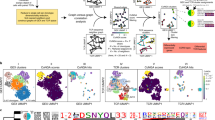Abstract
The CD8 antigen is a marker for T-lymphocyte subsets that is absent from helper T cells but expressed on cytotoxic T cells which recognize foreign determinants in association with class I major histocompatibility complex (MHC) antigens1. It has been suggested that CD8 plays some part in recognition by CD8+ cytotoxic T cells since anti-CD8 antibodies can block their functions2 and the human CD8 antigen contains a domain with clear similarities to immunoglobulin and T-cell receptor (TCR) variable-region (V) domains3,4. Human CD8 antigen is thought to be a homodimer5 but in the mouse and rat the equivalent antigens (alternatively called Lyt2,3 and OX8) are heterodimeric1,6. Rat CD8 contains two chains of relative molecular mass 32,000 (32K) and 37K: the 32K chain is the rat homologue of human CD8 and mouse Lyt2 (ref. 6). We describe here the molecular cloning of the rat 37K chain using an oligonucleotide probe predicted from peptide sequence. The full protein sequence is derived from the complementary DNA and matches limited peptide sequence for mouse Lyt3. The new sequence is more like immunoglobulin and T-cell receptor V domains than other T-cell antigens and includes a patch that is almost identical to some joining (J) piece sequences. This suggests that the CD8 and receptor heterodimers may have evolved directly from a common ancestor.
This is a preview of subscription content, access via your institution
Access options
Subscribe to this journal
Receive 51 print issues and online access
$199.00 per year
only $3.90 per issue
Buy this article
- Purchase on Springer Link
- Instant access to full article PDF
Prices may be subject to local taxes which are calculated during checkout
Similar content being viewed by others
References
Walker, I. D. et al. Immun. Rev. 82, 44–77 (1984).
MacDonald, H. R. et al. Immun. Rev. 68 89–115 (1982).
Littman, D. R. et al. Cell 40, 237–246 (1985).
Sukhatme, V. P. et al. Cell 40, 591–597 (1985).
Snow, P. M. & Terhorst, C. J. biol. Chem. 258, 14675–14681 (1983).
Johnson, P., Gagnon, J., Barclay, A. N. & Williams, A. F. EMBO J. 4, 2539–2545 (1985).
Walker, I. D. et al. immunogenetics 23, 60–63 (1986).
Zamoyska, R. et al. Cell 43, 153–163 (1985).
Nakauchi, H. et al. Proc. natn. Acad. Sci. U.S.A. 82, 5126–5130 (1985).
Luscher, B. et al. J. Immun. 135, 1937–1944 (1985).
Dayhoff, M. O., Barker, W. C. & Hunt, L. T. Meth. Enzym. 91, 524–545 (1983).
Maddon, P. J. et al. Cell 42, 93–104 (1985).
Barclay, A. N., Clark, M. J. & McCaughan, G. W. Biochem. Soc. Symp. 51, 149–157 (1986).
Sheppard, H. W. & Gutman, G. A. Proc. natn. Acad. Sci. U.S.A. 78, 7064–7068 (1981).
Gottlieb, P. D. J. exp. Med. 140, 1432–1437 (1974).
Sukhatme, V. P. et al. J. exp. Med. 161 429–434 (1985).
Reinherz, E. L., Meuer, S. C. & Schlossman, S. F. Immun. Today 4, 5–8 (1983).
Swain, S. L. Immun. Rev. 74, 129–142 (1983).
Gubler, U. & Hoffman, B. J. Gene 25, 263–269 (1983).
Thomas, M. L., Barclay, A. N., Gagnon, J. & Williams, A. F. Cell 41, 83–93 (1985).
Wallace, R. B. et al. Nucleic Acids Res. 9, 897–894 (1981).
Chirgwin, J. M., Przybyla, A. E., MacDonald, R. J. & Rutter, W. J. Biochemistry 18, 5294–5299 (1979).
Amzel, L. M. & Poljak, R. J. A. Rev. Biochem. 48, 961–997 (1979).
Siekevitz, M. et al. Eur. J. Immun. 12, 1023–1032 (1982).
Kabat, E. A. et al. Sequences of Proteins of Immunological Interest (Us Department of Health and Human Services, NIH, Bethesda, (1983).
Hedrick, S. M. et al. Nature 308, 153–158 (1984).
Chien, Y-h. et al. Nature 312, 31–35 (1984).
Clark, M. J., Gagnon, J., Williams, A. F. & Barclay, A. N. EMBO J. 4, 113–118 (1985).
Chien, Y-h. et al. Nature 309, 322–326 (1984).
Arden, B., Klotz, J. L., Siu, G. & Hood, L. E. Nature 316, 783–787 (1985).
Author information
Authors and Affiliations
Rights and permissions
About this article
Cite this article
Johnson, P., Williams, A. Striking similarities between antigen receptor J pieces and sequence in the second chain of the murine CD8 antigen. Nature 323, 74–76 (1986). https://doi.org/10.1038/323074a0
Received:
Accepted:
Issue Date:
DOI: https://doi.org/10.1038/323074a0
This article is cited by
-
Molecular analysis of protein interactions mediating the function of the cell surface protein CD8
Immunologic Research (1999)
-
Chromosomal localization of the genes encoding rat CD4, CD8α, and CD8β
Immunogenetics (1996)
-
Phylogeny and structure of the Ly‐2 and Ly‐3 (CD8) complex
Immunology & Cell Biology (1989)
-
Phosphorylation and down-regulation of CD4 and CD8 in human CTLs and mouse L cells
Immunogenetics (1989)
-
Structure and expression of the gene encoding CD8α chain (Leu-2/T8)
Immunogenetics (1989)
Comments
By submitting a comment you agree to abide by our Terms and Community Guidelines. If you find something abusive or that does not comply with our terms or guidelines please flag it as inappropriate.



